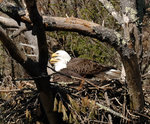 Narrowsburg
NarrowsburgLight Rain Fog/Mist, 43°
Wind: 8.1 mph
 Narrowsburg
NarrowsburgThose of us who have lived in the area long enough probably remember that once there were not as many bald eagles seen here as there are now. We may have seen some wintering eagles from Canada and …
Stay informed about your community and support local independent journalism.
Subscribe to The River Reporter today. click here
This item is available in full to subscribers.
Please log in to continue |


Those of us who have lived in the area long enough probably remember that once there were not as many bald eagles seen here as there are now. We may have seen some wintering eagles from Canada and other northern climes, but during the warmer spring and summer months, they were rare.
Because of the banning of DDT and the reintroduction efforts of bald eagles by various state agencies however, eagles are now here all year round. A single breeding pair of bald eagles first produced young in 1995 along the upper Delaware River corridor, and as of last summer, there were 21 active nests along the same 73-mile stretch of river.
Yet, a recent study that was published in the Journal of Wildlife Management determined that the bald eagle recovery has been slowed by four to six percent due to lead contamination. Krysten Schuler, senior author of the study and co-director of the Cornell Wildlife Health Lab, states, “The populations aren’t as resilient as they would be if lead wasn’t in the environment.” Schuler further states, “There’s not enough buffer within these populations to withstand mortality.” The concern is if an event happened, such as an outbreak of West Nile Virus, bald eagles would be less able to recover.
The study as published can be found here: https://bit.ly/3H6pd4p.
The average veterinarian or wildlife rehabilitator who deals with bald eagles knows all too well about lead poisoning with this species: if an affected eagle is found early enough, it may be able to be saved and eventually released back into the wild, but many are not found in time and succumb to lead poisoning. During the study, about 1,200 lab and necropsy records from Connecticut, Massachusetts, Maine, New Hampshire, New Jersey, New York and Vermont were obtained from various sources to determine how many bald eagles were exposed or succumbed to lead contamination.
Through veterinary, wildlife rehabilitator, state agencies, and other lab facilities, it has been determined that large numbers of eagles are ingesting lead particles from ammunition as they scavenge on the remains of field-dressed animals. When a lead hunting round strikes an animal, tiny fragments travel through and are deposited in the flesh and internal organs. In this manner, eagles may ingest enough lead to cause multiple organ failure, or smaller amounts that affect their ability to fly or even walk.
There is alternative ammunition available; copper ammunition has been around a while and has been improving. Copper rounds appear to perform equivalent to lead, and have better penetration, as copper retain about 90 percent of their weight vs. about 50 percent for lead rounds when fired into ballistic gel blocks. I have fired both lead and copper ammunition at 180 grain weight at 100-yard targets, and there was no difference noted in bullet drop; I save the lead for the range and bring the copper into the field.
If you use lead ammo in the field, there are still ways to prevent eagles from eating field-dressed animal parts that are contaminated with lead. Eagles hunt or scavenge by using their keen eyesight, so field dress with concealment in mind; don’t leave entrails in open fields where opportunistic eagles will find; if there is no choice, bury or cover with leaves or other available vegetation. Conifer trees, especially hemlock, make good hiding spots too. Even big rock crevices may be a good hide; anything to keep the eagle from seeing a free meal that could wind up being its last meal.
Comments
No comments on this item Please log in to comment by clicking here